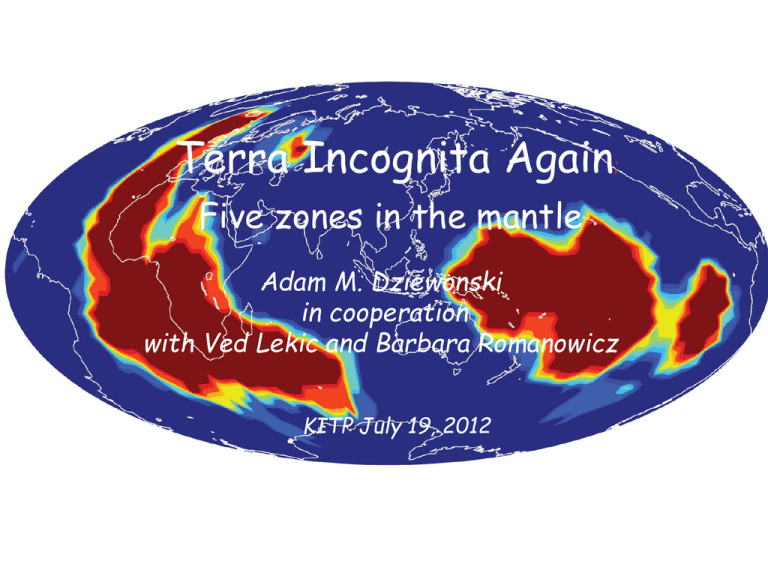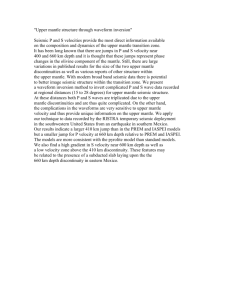slides
advertisement

Terra Incognita Again; Five zones in the mantle Adam M. Dziewonski in cooperation with Ved Lekic and Barbara Romanowicz KITP July 19, 2012 Convergence of 3-D models Ritsema et al., 2011 Different subsets of data have to be used to recover the whole mantle structure. Models obtained using only one subset of data are shown: Left: fundamental mode Center: overtones Right: teleseismic travel times Ritsema et al., 2004 Spectral characteristics of three recent models obtained using all three subsets of data Five zones in the mantle heterosphere Moho – 225 km upper mantle buffer zone 225-500 km transition zone 500-650 km lower mantle buffer zone 650-2400 km (Dziewonski et al., 2010) abyssal zone 2400 km - CMB Three upper mantle zones Heterosphere isotropic anisotropic Velocity anomalies change abruptly between 200 and 300 km depth From Ritsema et al., 2004 Rapid change in the level of heterogeneity at 200 – 250 km depth: heterosphere Romanowicz (2009) Crossing the 650 km discontinuity Model TX2008 has weak constrains in transition zone Model HMSL-S has no constraints in transition zone After Ritsema et al., 2011 Travel times of SS – SdS from 21,000 seismograms constrain topography of the 650 and 410 km discontinuities Topography of upper mantle discontinuities Gu and Dziewonski, 2001 Correlation of TZ velocity anomalies and 660 topography High correlation of the 660km discontinuity topography with velocity perturbations in the transition zone indicates ponding of heavier (cooler) material. There is no correlation with the anomalies below 660km. Stagnant slabs are common from Fukao et al. (2001) Lower Mantle Ritsema et al., 2011 Data and Model The dominant degree-2 signal is clearly visible in the data; the model at 2800 km depth looks very much like travel time anomalies of S-waves that bottom in the lowermost mantle. Lower mantle “slow – fast” regionalization 5 4 3 2 1 0 How similar are regionalizations based on cluster analysis of different tomographic models? Lekic et al. (2012) The Abyssal Layer Velocities Velocity gradient Voting vs. harmonic order Large scale features in different models are similar Caltech/Oxford Scripps A puzzle: Geodynamic functions; degrees 2 & 3 only Geoid Hot spots Seismic structure Subduction 0 – 120 Ma Richards & Engerbretsen, 1992 72 km 362 km Slabs at depth After Lithgow-Bertelloni and Richards, 1998 652 km 942 km 1377 km 2102 km j 2827 km It does not work! Slabs and seismic velocities; Degrees 1-12 Power spectra Sum: upper mantle 72 km 362 km Slabs at depth After Lithgow-Bertelloni and Richards, 1998 652 km 942 km 1377 km Sum: whole mantle 2102 km j 2827 km It works for the Upper Mantle! Comparison of seismic model S362ANI (left column) at 600 km and integrated mass anomaly for slab model L-B&R (right column). The top maps show the velocity model at 600 km and the whole-mantle integrated slab model for degrees 1-18. The bottom row shows degree-2 pattern only (note the changed color scale). It works for the whole mantle; degrees 2 &3 only! 2800 km All degrees Degree 2 Degrees 2 & 3 Comparison of seismic model S362ANI (left column) at 2800 km and integrated mass anomaly for slab model L-B&R (right column). The top maps show the velocity model at 2800 km and the whole-mantle integrated slab model for degrees 1-18. The middle row shows degree-2 pattern only (note the changed color scale), while the third row shows the combined degree 2 and 3 pattern. What does it mean? This means that velocity anomalies in the lowermost mantle represent a long time average of the subduction process. Degree 2 velocity anomalies at 2800 km, the Earth’s rotation axis and TPW paths of Besse and Courtillot (2002) S362ANI SAW24B S20RTS There is less than 1 in 1,000 probability that such a configuration of degree 2 is random. If low velocities are associated with a positive gravitational effect, then the axis of the minimum moment of inertia is in the equatorial plane. Two main points: • The characteristics of the spectrum of heterogeneity as a function of depth indicates the presence of five different regions: three in in the upper mantle and two in the lower mantle. • A very large structure at the bottom of the mantle imposes a permanent imprint on the tectonics at the surface. It determines a broad ring in which subduction can occur and regions of high hot-spot activity. What should CIDER do? The paradigm of whole mantle convection should be modified to account of zonation of mantle heterogeneity. This will require close and constructive cooperation of geodynamicists, seismologists, mineral physicists and geochemists. CIDER has now the means to support an effort to identify the issues that need to be addressed in order to achieve substantial progress. The next 10 slides were not shown Principal Component Analysis (PCA) A multi-dimensional function – a 3-D velocity model, for example – may be represented by a sum of multi-dimensional functions that are orthogonal: Δv(r,θ,φ) = ∑ λi • fi (r, θ, φ) Where λi are eigenvalues and ∫ fi • fj dV = δij The advantage of PCA is to determine the importance of different elements of the model. Variance reduction and the radial components of the largest PC’s of model S362ANI The first six PC’s: horizontal component Model obtained by using two largest PC’s compared to S362ANI (right) 69% variance reduction Model obtained by using six largest PC’s compared to S362ANI (right) 95% variance reduction Comparison of five models at a depth of 2800 km You cannot unmix convection After 4.5 billion years after the Earth accreted, the dominant component of lateral heterogeneity in the lowermost mantle still looks like the initial model of the convection experiment Degrees 2 & 3 tell most of the story S362ANI Degrees 2 & 3 Five model voting All degrees






